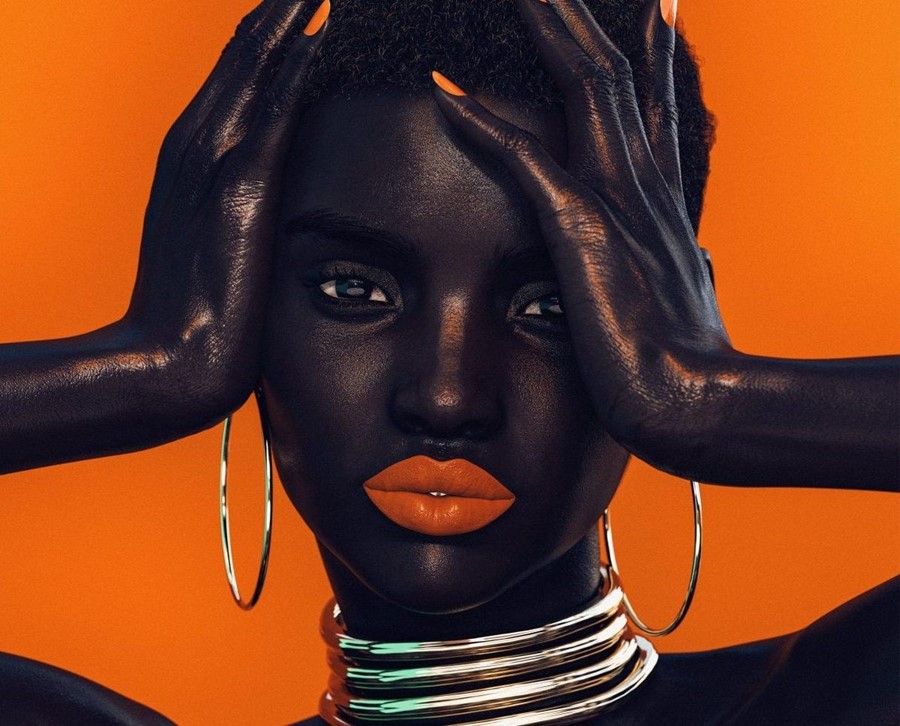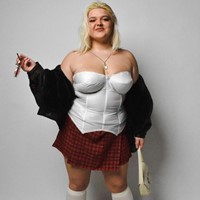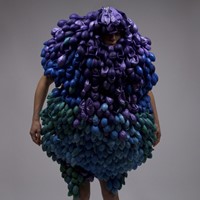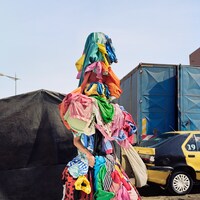We debate whether the rise in pixelated it-girls is innovation or just another way of replacing brown models
Maybe you’ve seen them while scrolling on Instagram, then stopped and scrolled back in disbelief. “Them” being CGI-created models. Yep, if beauty standards weren’t yet high enough, there are now uber-perfect models who don’t really exist – even if they do have personalities and their own social media accounts.
And being avatars hasn’t stopped them from being the faces of beauty labels or modelling in editorials for magazines. One of them even took over at Milan Fashion Week. Still, as you might imagine, reception to these new faces has been mixed – what do they represent? Is this just the creepy AF Pygmalion myth for generation Instagram? And what about the actual, IRL models they’re putting out of a job? Here, two writers argue for and against the use of CGI models in fashion.
FOR – ANY REPRESENTATION IS GOOD REPRESENTATION
Text Dominic Cadogan
Besides being a trillion dollar industry globally, fashion has always been about creating a world of fantasy, a way for people to escape. Look no further than the breathtaking creations of Alexander McQueen, or Comme des Garçons. Surely, the sudden takeover of CGI models is just another facet of fashion’s obsession with fantasy?
Digitally created, these new faces – including Lil Miquela, Shudu, and Nfon – aren’t limited by genetics or reality; they can take any form their creators envision. To me, it’s exciting. Discovering new models with interesting features is a big part of fashion, and now the possibilities are endless. Ours is an industry constantly obsessed with pushing forward and looking to the future – remember the “robots” at Chanel, and the fashion shoot with Sophia the robot? Don’t forget that for its SS16 campaign, Louis Vuitton enlisted Final Fantasy’s Lightning to front the collection – mostly to fanfare, if you go by the comments on the Instagram post. This feels like a natural next step.
The most recognisable name among this new wave of models is probably Lil Miquela. Since her first selfie back in 2016, she has now featured in shoots, took over Prada’s Instagram at its AW18 show, and modelled for Pat McGrath’s make-up line. Not to mention the fact she’s amassed just under a million followers on Instagram. It’s hard to ignore the hype – also, she just looks fucking cool with her bangs, Princess Leia-esque buns, and freckled cheeks. Really, she’s just like us – when she isn’t infiltrating fashion, she spends her time taking selfies and hanging out with her equally-cool, but actually real friends.
She also has a boyfriend – another CGI model, who got a sprinkle more fuccboi in the mix than his other half. At a quick glance, he’s like any other hypebeast, covering his face for selfies, and posting (terrible) memes on his Instagram account. See, they’re not so different to us. To hate them just because they’re holding a mirror up to the hyperreal, social-media obsessed state of society right now is ridiculous. They didn’t create the conditions that allowed for them to flourish, we did.
“Shouldn’t we be celebrating the fact that a dark-skinned, black woman is gaining popularity in fashion – even if she isn’t real?” – Dominic Cadogan
On a surface level, people might argue that the invention of fake CGI models signals the end of the modelling industry as we know it, and that “real” models will soon be out of jobs. This isn’t the case. E-commerce sites have photoshopped clothes onto digital bodies for years – but from catwalks to campaigns, actual models still get hired.
More seriously, there are those suggesting the creation of these CGI models is cultural appropriation. Particularly the photographer behind Shudu – described on her IG account as the World’s First Digital Supermodel – since he is white, and male. Yes, it is problematic. Particularly as her likeness comes from models like Duckie Thot and Alek Wek, making it hard not to seem like fetishisation. But for those suggesting her creator is profiting from her, they are way off the mark. Shudu was never created for commercial reasons, and again, is a way for us to live through fantasy. Her legs go on for what seems like forever, and she can effortlessly go from serving African neck coils (and nothing else) to an ultra-sexy look, to twinning with her boo, Nfon with her natural hair.
Take a look at her Instagram, it is completely captivating. Rather than being cynical, shouldn’t we be celebrating the fact that a dark-skinned, black woman is gaining popularity in fashion – even if she isn’t real? That isn’t to discredit or erase existing or new black models and, in fact, could help promote conversations around diversity in fashion.
It shouldn’t go unmentioned that all of the CGI models currently are the forefront are POCs, which is more that can be said for the majority of runway shows. If this is the new frontier of the modelling industry, these numbers are looking very favourable.
AGAINST – BRANDS LOVE POC’S AESTHETICS BUT NOT POC
Text Kemi Alemoru
I’m someone that exists on the fringes of what is fashionable. For example, I don’t actually own any luxury items and spend Monday-to-Friday throwing together the first things I see strewn across my floordrobe. Nevertheless, even though I don’t feel a part of the industry I know what is trending and right now people of colour are having a “moment”.
For years, all-white campaigns were something you’d never bat an eyelid to. Now, a make-up ad or streetwear campaign without any people of colour looks incredibly out of touch. You see this in how something as simple as swatching cosmetic collections is inherently political post-Fenty Beauty, with companies being dubbed “embarrassing” if their darker shade range is limited.
Just this week a “colonialism” themed fashion line modelled by a white man sparked outrage for being so obviously tone-deaf. This is probably because young people have become increasingly empathetic towards race issues since social media has made debates more accessible. The absence of black, asian, hispanic faces in your brand only help to strengthen online discourse about exclusion and prejudice. In short, it’s just not good for your brand to exclude people of colour (POC) right now.
This backdrop is impossible to ignore when considering the rise of CGI influencers of colour. Some commentators think the likes of Lil Miquela and Shudu are a clever comment on authenticity on social media or the fashion industry’s obsession with perfection. However, there’s a danger that this is just another vehicle for brands to cash in on what is popular without having to give props and jobs to POC.
Take Lil Miquela. Her feed is very of-the-moment oscillating between streetwear looks and pivotal pop culture moments like celebrating Lena Waithe’s Vanity Fair cover after becoming the first black woman to win an Emmy for comedy writing. She’s vocal about social issues in Bushwick, Brooklyn – an area of New York where only 9 per cent of the population is white. Aided by her ethnic ambiguity, the Spanish-Brazilian Californian has enough cultural cache to talk about racial issues like Black Lives Matter while managing to look socially conscious, rather than aggressive or divisive. If Miquela was actually real, her radical passion and ethnicity might work against her. Luckily, she is a pixelated simulacrum – an embodiment of what is popular – without the burden of actually having to exist. So she’s picking up brand partnerships at quite a rate, while influencers of colour remain largely ignored by luxury brands.
In February, Prada and Miquela teamed up for an Instagram takeover. Until recently, the brand’s record on diversity has been questionable – before Jourdan Dunn in 2008, the last black model to walk for the brand was Naomi Campbell in 1993. While Miquela was taking over on IG, Sudanese-American model Anok Yai became the first black model to open a Prada runway show in more than 20 years. So while it’s props to Prada for helping Yai make her way into the industry, couldn’t they have given their social media accounts to an IRL POC?
“Brands can borrow Shudu’s deep melanated skin, Nfon’s wide sculpted features, and Miquela’s feisty online persona without the hassle of smashing the glass ceiling to let POC reach the top” – Kemi Alemoru
This isn’t an isolated issue. In 2016, a Fashion Spot report found that almost 80 per cent of models in luxury brand ads were white. Yet, the “world’s first digital supermodel” Shudu, has 99.5k followers and a burgeoning career. She has already modelled Oscar de la Renta jewellery, Fenty lip shades, and has a host of viral shoots with her male counterpart Nfon.
Shudu and Nfon are the brainchild of London-based photographer and digital artist Cameron-James Wilson who told Harper’s Bazaar that Shudu was his “art piece”. “She is not a real model unfortunately, but she represents a lot of the real models of today. There’s a big kind of movement with dark skin models, so she represents them and is inspired by them," he explained. “Obviously some models like Duckie (Thot) were definitely big inspirations for her as well.” Funnily enough, Thot has been vocal about how difficult it was to get her start in the industry because of her shade.
What Wilson is inadvertently saying is that black people are trendy right now, not because the industry wants to improve its shocking record diversity, but purely because people love the black aesthetic. It’s objectification in its purest form. Now brands can borrow Shudu’s deep melanated skin, Nfon’s wide sculpted features, and Miquela’s feisty online persona without the hassle of smashing the glass ceiling to let POC reach the top.
In the past, I’ve argued against the boring backlash of calling individuals out for appropriation when they borrow from black culture. Enjoying someone else’s culture is a natural way to appreciate differences and develop culture in music, fashion, and beauty – if you cite your influences then it’s all good. However, what I do take issue with is a whole industry that clearly favours black and minority ethnic aesthetics on anyone but minorities.
To champion a coded character over POC influencers and models looking for jobs is nothing short of fetishisation. As Naomi Campbell told GQ recently: “We’re not a trend.” If you like what women of colour represent, and how they look, then hire them. They should be remunerated and championed. Until then, your CGI imitations only prove that you love the looks of POC, but not the reality of us.




